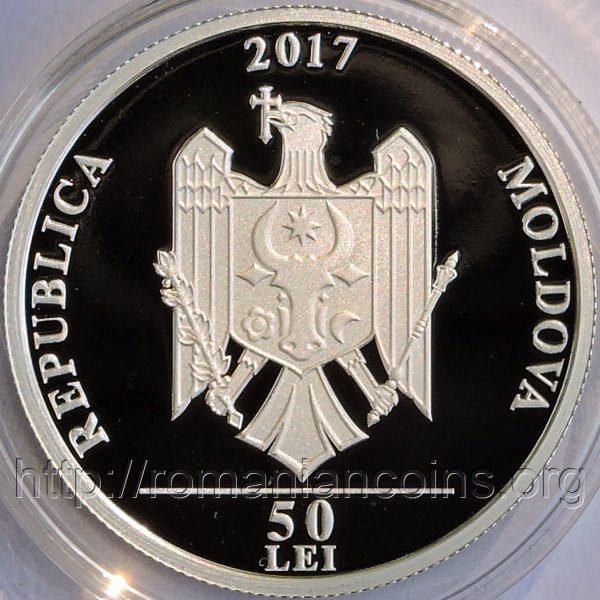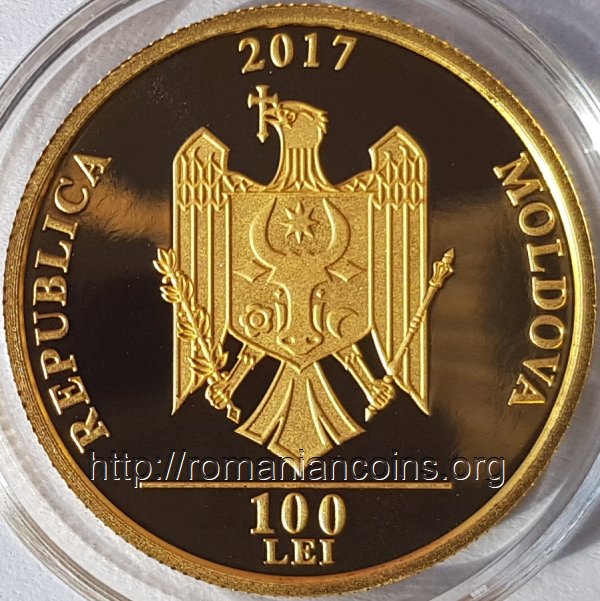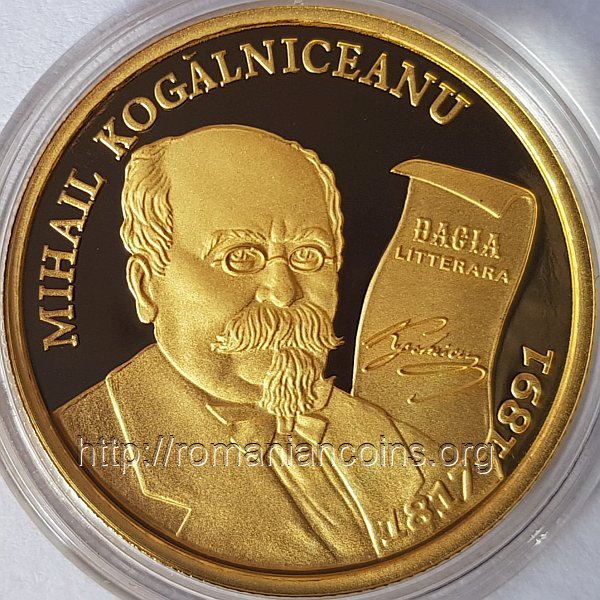
|
50 and 100 lei 2017 (2018) - Mihail Kogălniceanu |
|

|

|
|
28 mm diameter, 13 g, 99.9% silver, grained edge year 2017, circular inscription REPUBLICA MOLDOVA meaning "REPUBLIC OF MOLDAVIA" and the coat of arms of the Republic of Moldavia, in exergue horizontal line and denomination "50 LEI" |
bust of the politician, a sheet of paper with his signature and title of the magazine "DACIA LITTERARA" meaning "LITERARY DACIA", inscription MIHAIL KOGĂLNICEANU and years 1817-1891
Issuing date: 27th of March 2018 Mintage: 200 coins |

|

|
|
24 mm diameter, 7.8 g, 99.99% silver, grained edge year 2017, circular inscription REPUBLICA MOLDOVA meaning "REPUBLIC OF MOLDAVIA" and the coat of arms of the Republic of Moldavia, in exergue horizontal line and denomination "100 LEI" |
bust of the politician, a sheet of paper with his signature and title of the magazine "DACIA LITTERARA" meaning "LITERARY DACIA", inscription MIHAIL KOGĂLNICEANU and years 1817-1891
Issuing date: 27th of March 2018 Mintage: 100 coins |
The coins belong to the series Alley of the Classics from the public garden "Stephen the Great and the Holy" in Chișinău.
The pictures of the gold coin are present on Romanian coins through the kind permission of an anonymous donor.
The historical note on the certificate of authenticity accompanying the coin states: "Mihail Kogălniceanu (1817 - 1891) - witer, lawyer, historian, diplomat originating in Moldavia. Important personality of our nation, one of the most influential Romanian intellectuals of his generation. He was founding member of the Romanian Academic Society, president of the Romanian Academy, President of the Minister Council, Prime Minister of Romania, as well as one of the most notable leaders of the Liberal National Party. He read Romania's Declaration of Independence inside the Chamber of Deputies, at the 9th of May 1877. Mihail Kogălniceanu, great intellectual, he successfully contributed to the reasearch into national history and the development of Romanian literature. He founded reviews "Dacia literară" [Literary Dacia], "Arhiva românească" [Romanian Archive], "Propășirea" [Progress] and established the basis for the literary "pașoptist" ['48-ers] current.".
Mihail Kogălniceanu draws his family name from the River Cogîlnic, flowing in the eastern half of Moldavia, which lies between Rivers Prut and Nistru, and was called Basarabia after the Russian annexation of 1812. The use of letter "K" [which does not alter pronounciation], as well as diacritical letter "ă" are historical in the spelling of the name Kogălniceanu, hence the difficulty to associate the personality whith the river.
Below, the words of Kogălniceanu about Basarabia, during the Independece War:
<<May God bestow that I am wrong [in so saying], nevertheless I reckon very many storms will come in the future over this piece of earth that we call the Romanian Basarabia.>>
(from a letter of Mihail Kogălniceanu on January 26th 1878) [1].
References
1. Brătianu Gh., Basarabia: drepturi naționale și istorice. Editura Tritonic, București, 2004 (traducere după "La Bessarabie: Droits nationaux et historiques, București, Institut d'Histoire Universelle "N. Iorga", 1943).
|
Back to selection page!
|